January 2nd, 2025 | Posted in Data & Insights
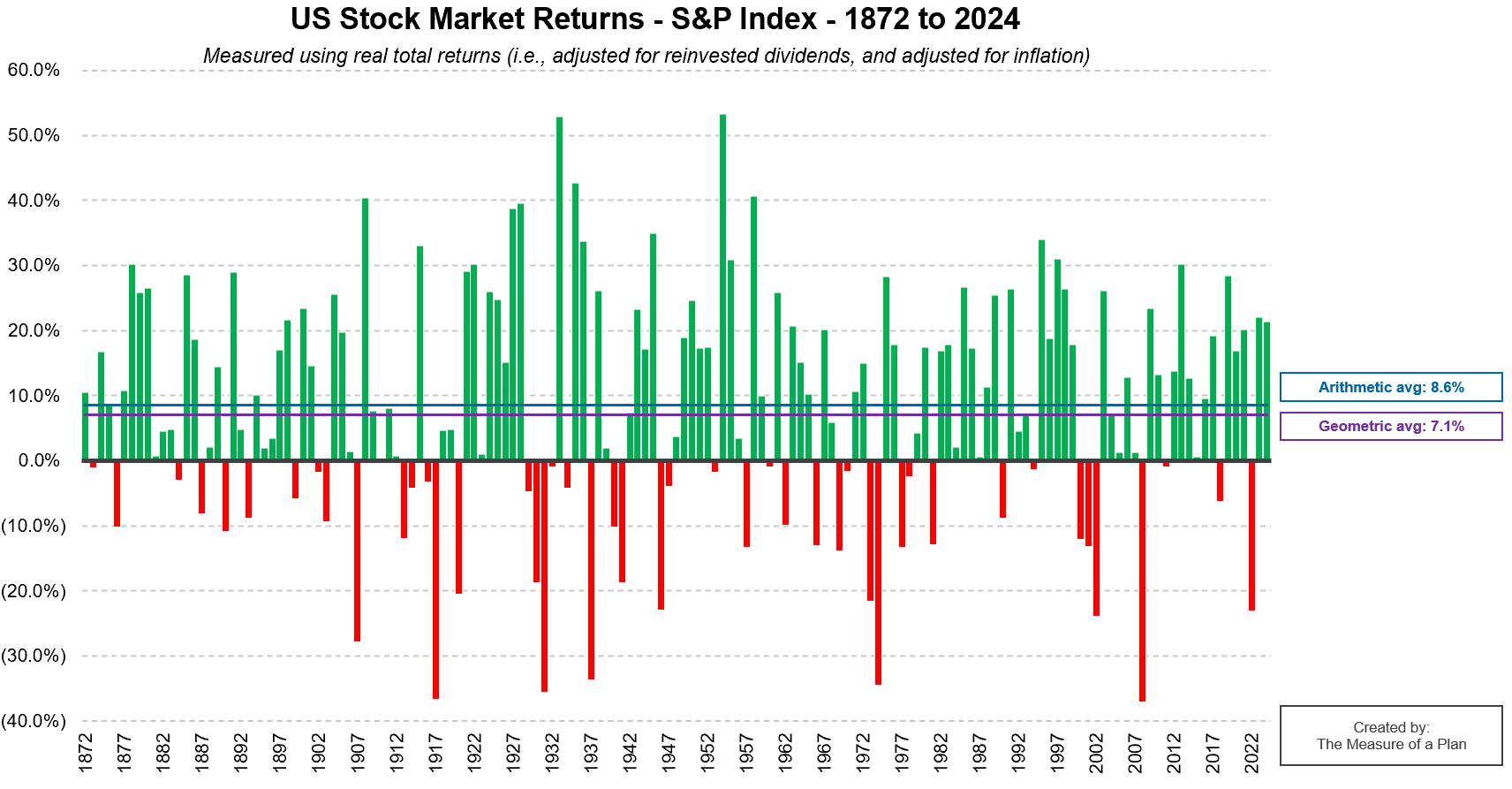
Note: This post was last updated on January 2, 2025 to include refreshed U.S. stock market returns up until the end of 2024. The U.S. stock market grew by +21.5% in 2024 📈 (using a real total return measurement)
From Canada to Chile, Barcelona to Bali — investors around the globe pay close attention to the U.S. stock market. With the U.S. generating ~25% of global GDP, and U.S. companies weighing in at ~60% of global stock markets, the performance of everyone’s investments is heavily swayed by the performance of the American market.
This post will cover several facts and figures about the history of U.S. stock market returns:
- What is the average return of the stock market?
- How often does the stock market go down?
- Gauging the impact of short vs. long time horizons on the likelihood of losing money in the market
- The best/worst months and decades in stock market history
Understanding historical stock market returns can help to inform your financial plans, from planning for retirement, or figuring out whether it makes more sense to rent or buy your home. Plus, it’s plenty of fun for data geeks like myself 🧐
Throughout this post we’ll be relying on a fantastic data set released and maintained by Professor Robert Shiller, giving us data on U.S. stock market returns all the way back to the 1870s — a data set covering more than 150 years.
Onto the good stuff!
U.S. Stock Market Returns by Year
What is the average annual return of the U.S. stock market?
- Simple Average: the average return of the U.S. stock market has been 8.6% per year over the past ~150 years (1872 to 2024); this is the “simple” average across all years (also known as the “arithmetic” average)
- Annualized Average: the return of the U.S. stock market has been 7.1% per year on an annualized average basis, over the past ~150 years. This represents the compounded annual growth return (“CAGR”, a.k.a “geometric average”) that you would have earned if you’d invested over this whole period
This showcases why many financial planners tend to assume returns of 5% to 8% per year in the stock market.
Recent U.S. stock market returns over the past 5 years have been:
- 2024: +21.5%
- 2023: +22.1%
- 2022: -23.1%
- 2021: +20.2%
- 2020: +16.9%
Note: all figures mentioned above / shown in the chart are “real total returns”, meaning that they’ve been adjusted to include the re-investment of dividends, and have also been adjusted for the impact of inflation.
Distribution of Annual Returns / Likelihood of Losing Money
How often does the stock market go down?
- While the U.S. stock market has generally grown over time, we don’t always see rainbows and unicorns. The market has grown in 69% of all years, and declined in 31% of all years on record
- U.S. stock market returns in any single year can be extremely volatile. There have been 5 cases where the market declined by 30 to 40% in a single year (1917, 1931, 1937, 1974, and 2008)
- You don’t need to go back too far for evidence of losses in the stock market — in 2022, the U.S. stock market dropped by 23.1% (real total return of the S&P 500 index)
Buy, Hold… Profit?
The wild swings of the market are reduced if we start to look at time horizons that are longer than a single year.
In the animation below, you can see how U.S. stock market returns have fared when we look at 1 / 5 / 10 / 20 year rolling periods.
- Taking a 1-year view, we see lots of red — there were plenty of years in which the market was down, and sometimes down significantly.
- As we look to longer and longer time periods (stretching our view out to 5 years, then 10 years, and finally 20 years), the range of possibilities narrows, and the chance of losing money diminishes.
- Once we zoom it out to look at returns over 20-year periods, you won’t see any more flashes of red. In other words, The U.S. stock market has never declined over any 20-year period in history.
And down below you’ll find the same chart, but this time shown as a static picture rather than an animation.
To summarize: while the range of returns across 1-year periods has varied significantly (from negative 37.0% to +53.2%), the annualized returns across 20-year periods have a much tighter range (from +0.5% to +13.2%).
Over the long run, U.S. stocks have delivered strong positive returns. However, if your investment horizon is short (0-5 years), there is a substantial likelihood that you could lose money by investing in the stock market. Therefore, for short-term savings, it’s recommended that you choose less volatile investment assets such as bonds, GICs, or high interest savings accounts — these investments offer lower reward and lower risk.
U.S. Stock Market Returns by Decade
Across the entire period spanning 1871 until 2024, U.S. stocks have increased at an annualized average of +4.8% per year excluding dividends, +9.3% per year including dividends, and +7.1% per year including dividends and also adjusting for inflation (i.e., the real total return CAGR).
The stock market can decline even over a relatively long time period of 10 years. For example, an investor in the U.S. stock market during the period of 2000 to 2009 would have faced an average loss of 3.4% per year during that decade. This loss was due to the burst of the dot-com bubble in the early 2000s, and the sub-prime financial crisis of 2008.
The Best and Worst Months in Stock Market History
The table below lists the 20 months on record with the highest returns, and the 20 months with the lowest returns (without adjusting for dividends or inflation).
A familiar story: in the short-term, the stock market is far from predictable.
The best month in stock market history was August 1932, when the market gained 50.3% in a single month!
On the other hand, the worst month in stock market history was November 1929, with a decline of 26.5%. The worst month in recent history came in October 2008 (during the depths of the Great Recession), when the stock market dropped by 16.9%.
$1,000 — Then and Now
If you had invested $1,000 in the U.S. stock market on Dec. 31st, 1969 and held the investment until Dec. 31, 2024 (without buying or selling during that 55-year period), your investment would have grown to ~$288k before considering inflation, or ~$34k after adjusting for inflation.
Historically, buying and holding (and potentially forgeting about the investment entirely) has been a simple and straightforward way to build wealth.
Final Thoughts
If you’re looking to make a quick buck by jumping in and out of the market, quite often you’ll find yourself on the losing end of things. Over short time periods, there’s no telling if the market will go up, down, or sideways.
However, if you have the patience and fortitude to hold onto your investments for 10 or 20+ years, your prospects become much brighter. You’ll ride out the short-term noise and benefit from the long-term upwards trend 🚀.
As usual, legendary investor Warren Buffet put it best: “the stock market is a device for transferring money from the impatient to the patient”.
That being said — if you’d like to try your hand at beating the performance of a simple buy-and-hold strategy, I invite you to play this simple market timing simulator game.
If you liked this post, you may be interested in some of my other tools and data essays:
- Free spreadsheets and tools for budgeting, investment portfolio tracking, and more
- Tracking Canadian Housing Market Affordability (1999 to 2024)
- The Wealth of Nations: income, cost of living, and purchasing power for 110 countries
- Investment returns by asset class (1985 to 2024)
***
For the data-heads, click here to download an excel file which contains all of the underlying data on U.S. stock market returns, along with the charts shown in this post.
Data sources:
Robert Shiller U.S. stock market data
Yahoo finance S&P 500 historical data
FRED U.S. CPI (inflation) data
Note 1: for the purposes of this post, the “U.S. stock market” refers to the S&P Composite index from 1871 to 1957, and the S&P 500 index from 1957 until today, which is aligned with the definition used by Professor Shiller.
Note 2: All values shown in this post are real total returns (returns including dividends and adjusting for the impact of inflation), unless explicitly stated otherwise.
That’s all for now! Thanks for joining me on this data deep dive 🧐. Feel free to drop any comments or questions below.

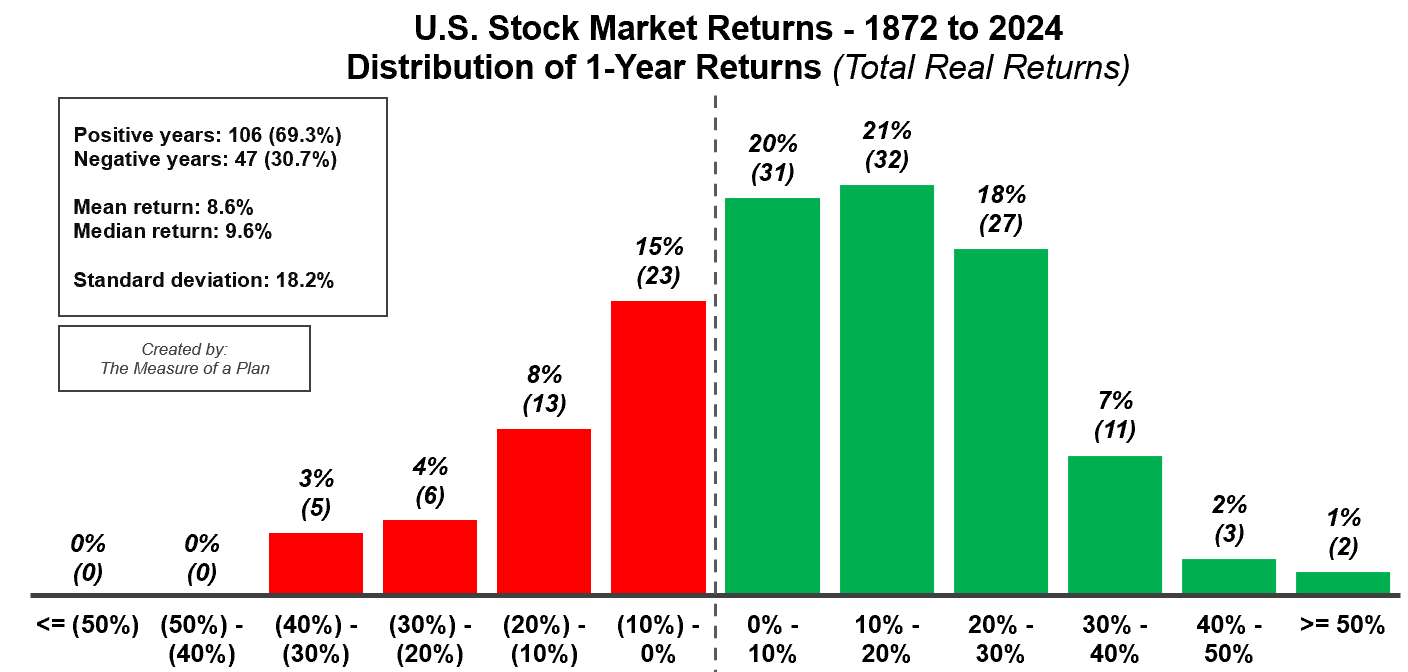
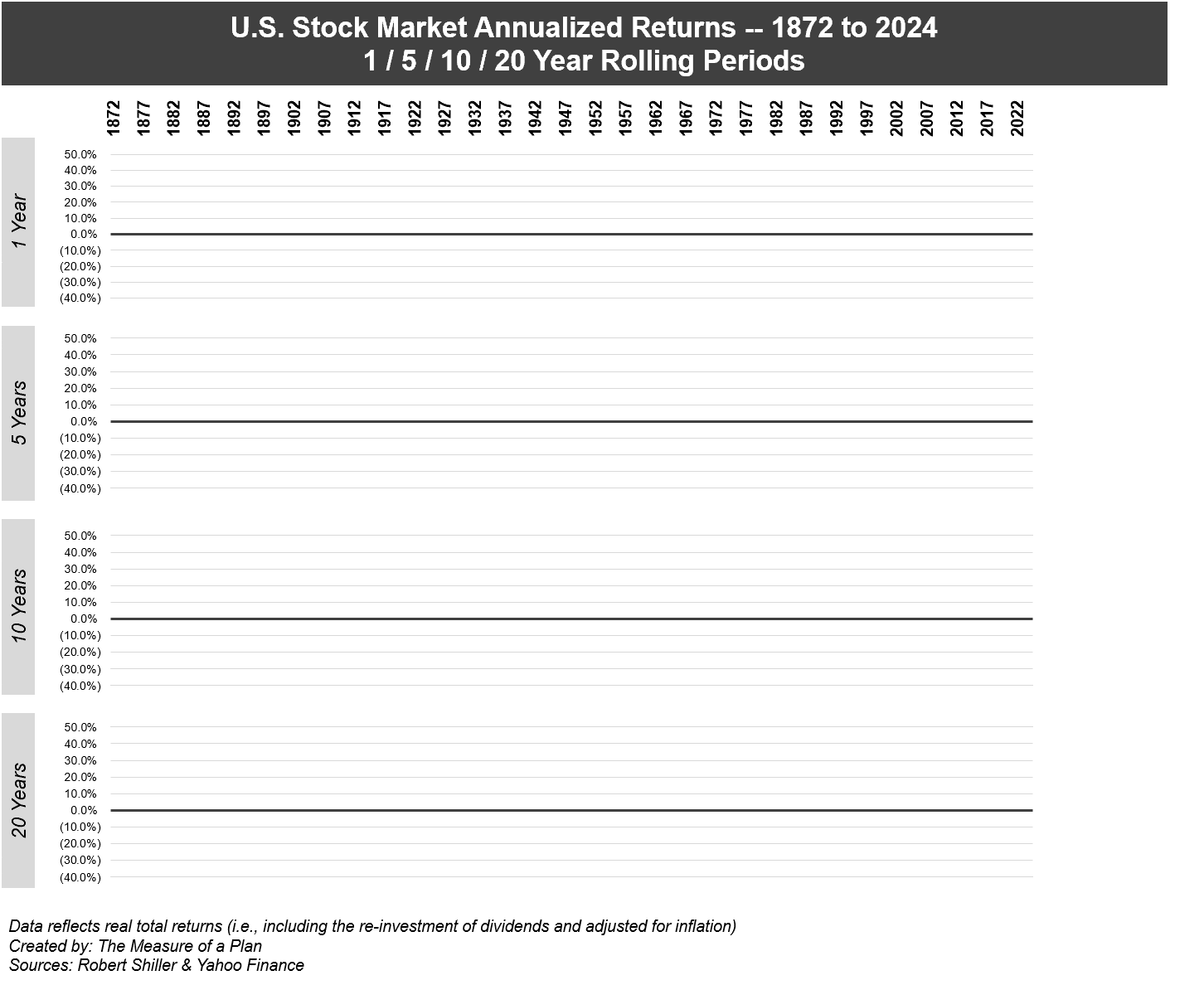
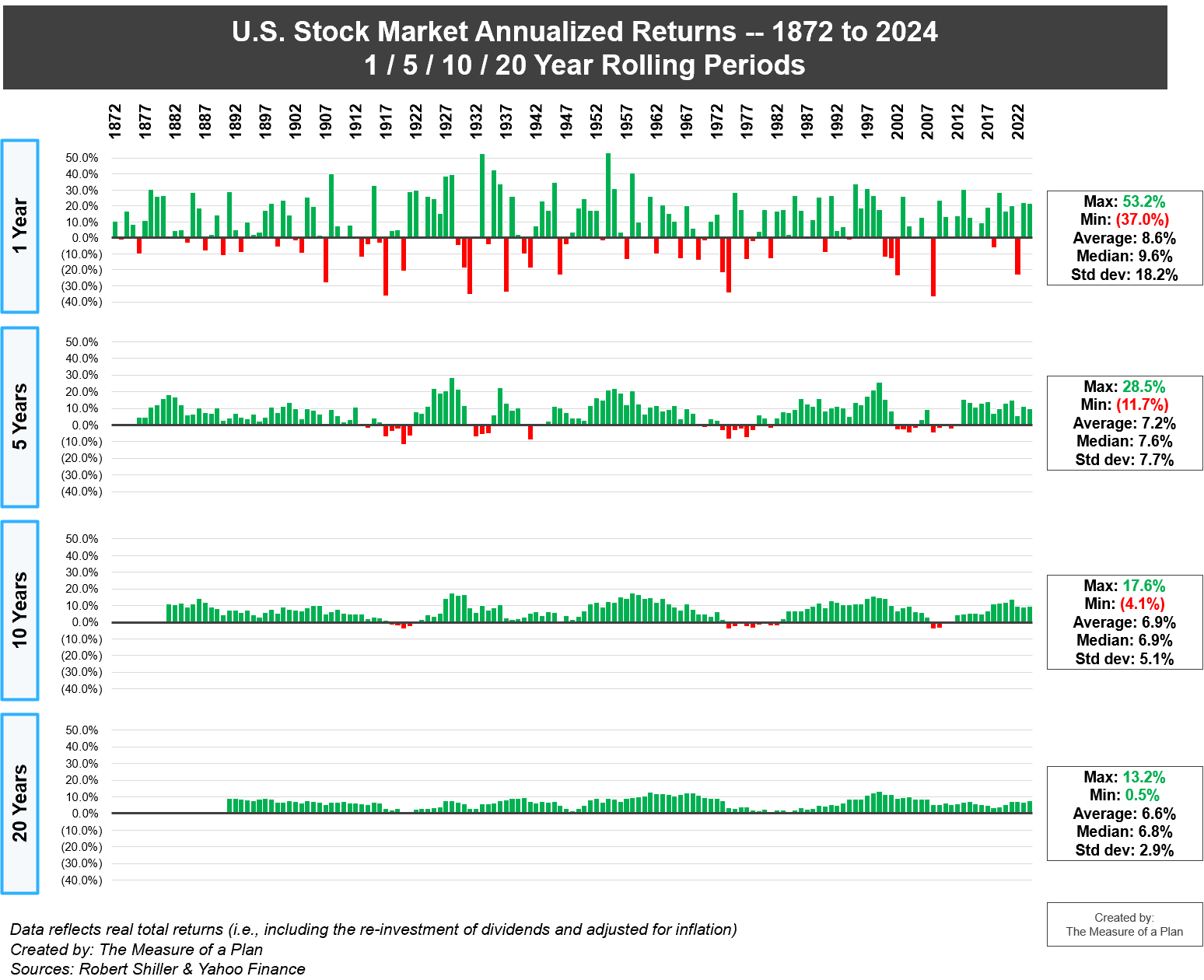
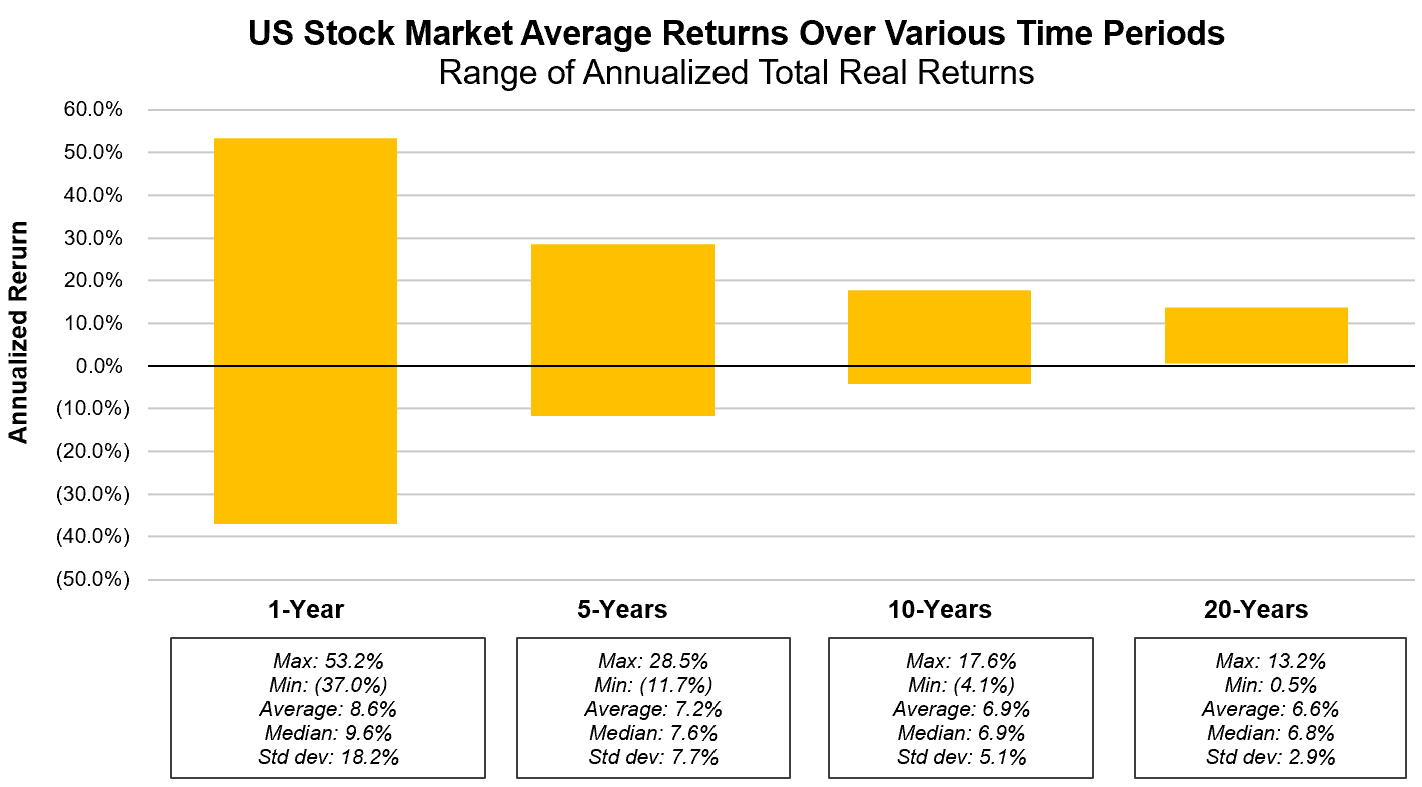
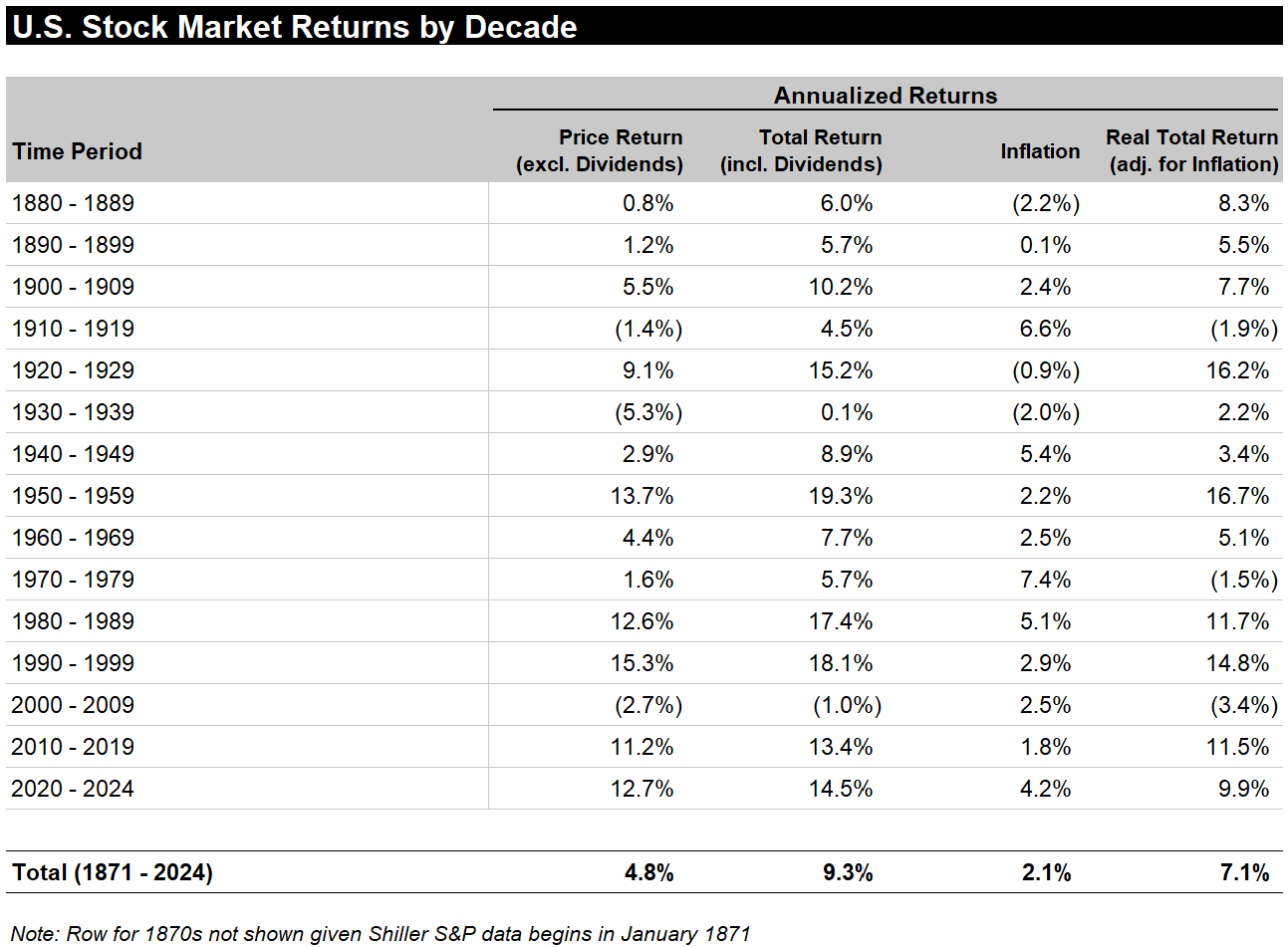
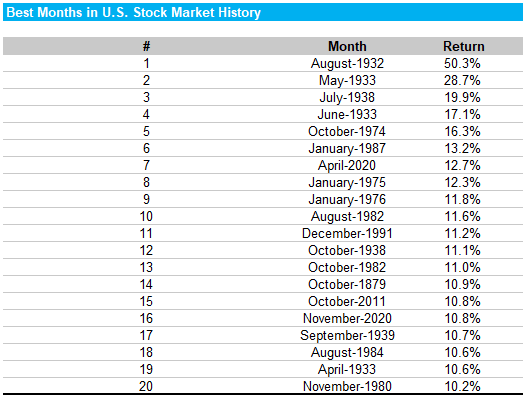
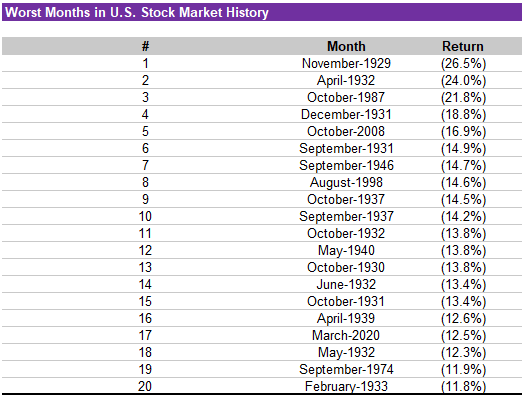
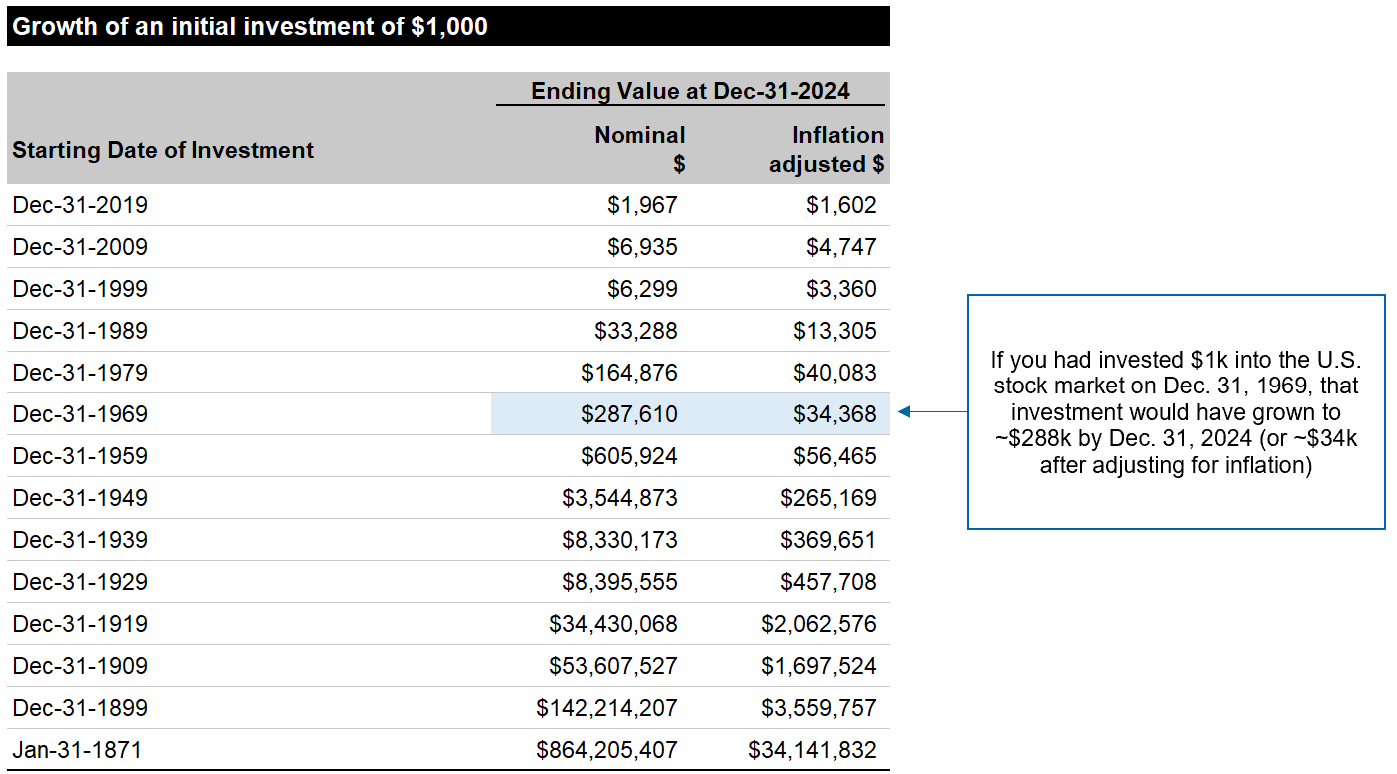
Clearly shows the power of buying and holding high quality assets for decades.
Thanks for sharing.
Absolutely.
1-year holding periods in the market can be scary. Over 10 or 20 years, the long-term upwards pattern really shines through.
[…] The Measure of a Plan […]
[…] The article in question here is U.S. Stock Market Returns – 1870s to Present […]
Wonderful website. I stumbled across it looking for a baby budgeting tool but found a wealth of information. Thank you.
In the article you mentioned that a rolling period of 20 years has never lost money. Is it safe to assume that if you increase this rolling period to 25 or 30 years, they would not lose money either?
Is it possible to know what the ranges of returns would be for 25 and 30 years?
Hey Vizzy,
You are very welcome. Thank you for the kind words.
Your assumption would be safe! I just did the calculations for 25 / 30 year rolling periods. The trend continues — as the time horizon lengthens, the range of returns gets tighter and tighter.
25 years: min of 2.6%; mean of 6.7%; max of 11.7%
30 years: min of 3.3%; mean of 6.6%; max of 10.4%
[…] No reference is given and I know that to be untrue not only for inflation-adjusted returns, but also for nominal (strictly numerical) returns. The graphs on pages 122 and 123 bear that out, using the Dow Jones Industrial Average as a guide, but the same is true of other indices like the S&P 500. There have definitely been 10-year periods where the markets have been down. […]
[…] animation comes to us from The Measure of a Plan, and it shows the performance of the U.S. market over different rolling time horizons using […]
A few years ago one of the major investment firms, Fidelity I believe, went back and analyzed their most successful portfolios under their management. The most successful portfolio was identified as those who had been forgotten. In other words the investment had not had a buy or sell for decades and they had highest percentage of growth. A behavior to duplicate was identified.
Thanks Clint. I’ve heard the same story: https://www.businessinsider.com/forgetful-investors-performed-best-2014-9
It’s a critical point to keep in mind — the average investor simply isn’t very good at timing the market.
Another great way I’ve heard it put: “Your portfolio is like a bar of soap; the more you touch it, the less you have!”
Thanks for the info. Great insight. Quick question though. $1000 now and then chart… does $1000 account for the inflation? For example, $1000 in 1939 would be worth around $18,200 now. Still a great plot
Thanks Bobby.
The “$1000 then and now” chart has a column which is in nominal dollars (i.e., not inflation adjusted), and another column which is in real dollars (i.e., adjusting for inflation).
So if you had invested $1,000 in 1939 (in actual 1939 dollars), you’d have ~$3.6M today (in 2019 dollars). Adjusted for inflation, you’d have ~$200K today (in 1939 dollars).
[…] The Measure of a Plan created this fantastic visual that details the range of return the U.S. stock market has delivered over one-, five-, ten-, and twenty-year rolling time periods. […]
[…] Invierte a largo plazo!! Esa es la conclusión que se podría inferir de la animación publicada por The Measure of a Plan. […]
[…] market has provided generous returns for those willing to stay invested. As this cool chart from Measure of a Plan shows, the longer an investor’s time horizon, the strongest a chance of positive stock market […]
[…] few years ago I came across an article that showed the return of the stock market by holding period. As you might expect, for any given […]
[…] tends to rise (though of course past performance is no guarantee of future results). For example, the U.S. stock market has never lost money over any 20 year period. However, along the way, there is a lot of volatility. For that reason, I and others do not […]
[…] animation comes to us from The Measure of a Plan, and it shows the performance of the U.S. market over different rolling time horizons using […]
[…] animation comes to us from The Measure of a Plan, and it shows the performance of the U.S. market over different rolling time horizons using […]
[…] U.S. Stock Market Returns – 1870s to Present (themeasureofaplan.com) […]
[…] maar op lange termijn rekent men op een gemiddelde opbrengst van 7-8 % per jaar. In de VS was het gemiddelde reële rendement (na inflatie) tussen 1872 en 2018 8,4%. Dit gemiddelde verbergt uitschieters naar boven en naar beneden (bv. 30% winst in 2013 en 38% […]
[…] heutige Animation stammt von The Measure of a Plan und zeigt die Performance des US-Marktes über verschiedene Rolling-Time-Horizonte unter Verwendung […]
[…] courtesy of Measure of a Plan. Check them out […]
[…] heutige Animation stammt von The Measure of a Plan und zeigt die Leistung des US-Marktes über verschiedene rollierende Zeithorizonte anhand der […]
[…] us-stock-market-returns-1870s-to-present […]
[…] 根據過去146年的歷史統計,長期下來市場單年出現上漲的機率是70%,下跌則是30%。 […]
[…] animation comes to us from The Measure of a Plan, and it shows the performance of the U.S. market over different rolling time horizons using […]
[…] has delivered negative returns in 31% of the years in its history, according to data gathered by Measure of a Plan, a personal finance website. But there hasn’t been a single 20-year period in which it has lost […]
[…] has delivered negative returns in 31% of the years in its history, according to data gathered by Measure of a Plan, a personal finance website. But there hasn’t been a single 20-year period in which it has lost […]
[…] négatifs au cours de 31 % des années de son histoire, selon les données recueillies par Mesure d’un plan, un site de finances personnelles. Mais il n’y a pas eu une seule période de 20 ans au cours […]
[…] has delivered negative returns in 31% of the years in its history, according to data gathered by Measure of a Plan, a personal finance website. But there hasn’t been a single 20-year period in which it has lost […]
[…] négatifs au cours de 31 % des années de son histoire, selon les données recueillies par Mesure d’un plan, un site de finances personnelles. Mais il n’y a pas eu une seule période de 20 ans au cours […]
[…] has delivered negative returns in 31% of the years in its history, according to data gathered by Measure of a Plan, a personal finance website. But there hasn’t been a single 20-year period in which it has lost […]
[…] has delivered negative returns in 31% of the years in its history, according to data gathered by Measure of a Plan, a personal finance website. But there hasn’t been a single 20-year period in which it has lost […]
[…] has delivered negative returns in 31% of the years in its history, according to data gathered by Measure of a Plan, a personal finance website. But there hasn’t been a single 20-year period in which it has lost […]
[…] has delivered negative returns in 31% of the years in its history, according to data gathered by Measure of a Plan, a personal finance website. But there hasn’t been a single 20-year period in which it has lost […]
[…] has delivered negative returns in 31% of the years in its history, according to data gathered by Measure of a Plan, a personal finance website. But there hasn’t been a single 20-year period in which it has lost […]
[…] has delivered negative returns in 31% of the years in its history, according to data gathered by Measure of a Plan, a personal finance website. But there hasn’t been a single 20-year period in which it has […]
[…] returns in 31% of the several years in its record, in accordance to knowledge gathered by Evaluate of a System, a personal finance web-site. But there hasn’t been a solitary 20-calendar year period of time in […]
[…] has delivered negative returns in 31% of the years in its history, according to data gathered by Measure of a Plan, a personal finance website. But there hasn’t been a single 20-year period in which it has lost […]
[…] adverse returns in 31% of the years in its historical past, in accordance to details gathered by Evaluate of a System, a particular finance internet site. But there hasn’t been a single 20-yr period of time in which […]
[…] As an example, look at the Vanguard 500 Index Fund (VFIAX), which tracks the performance of the S&P 500. In 2018, the fund actually had a negative return of -4.38%. And during the recession in 2008, it had a negative return of -37%. But over long periods of time, the index has gone steadily up. There hasn’t been a single 20-year period in its history in which the S&P 500 posted negative returns, according to data compiled by Measure of a Plan. […]
[…] As an example, look at the Vanguard 500 Index Fund (VFIAX), which tracks the performance of the S&P 500. In 2018, the fund actually had a negative return of -4.38%. And during the recession in 2008, it had a negative return of -37%. But over long periods of time, the index has gone steadily up. There hasn’t been a single 20-year period in its history in which the S&P 500 posted negative returns, according to data compiled by Measure of a Plan. […]
[…] As an example, look at the Vanguard 500 Index Fund (VFIAX), which tracks the performance of the S&P 500. In 2018, the fund actually had a negative return of -4.38%. And during the recession in 2008, it had a negative return of -37%. But over long periods of time, the index has gone steadily up. There hasn’t been a single 20-year period in its history in which the S&P 500 posted negative returns, according to data compiled by Measure of a Plan. […]
[…] As an example, look at the Vanguard 500 Index Fund (VFIAX), which tracks the performance of the S&P 500. In 2018, the fund actually had a negative return of -4.38%. And during the recession in 2008, it had a negative return of -37%. But over long periods of time, the index has gone steadily up. There hasn’t been a single 20-year period in its history in which the S&P 500 posted negative returns, according to data compiled by Measure of a Plan. […]
[…] a 150-year study of the U.S. stock market by Nobel Laureate Robert Shiller, if you invested […]
[…] a 150-year study of the U.S. stock market by Nobel Laureate Robert Shiller, if you invested […]
[…] a 150-year study of the U.S. stock market by Nobel Laureate Robert Shiller, if you invested […]
[…] a 150-year study of the U.S. stock market by Nobel Laureate Robert Shiller, if you invested […]
[…] a 150-year study of the U.S. stock market by Nobel Laureate Robert Shiller, if you invested […]
[…] a 150-year study of the U.S. stock market by Nobel Laureate Robert Shiller, if you invested […]
[…] a 150-year study of the U.S. stock market by Nobel Laureate Robert Shiller, if you invested […]
[…] a 150-year study of the U.S. stock market by Nobel Laureate Robert Shiller, if you invested […]
[…] a 150-year study of the U.S. stock market by Nobel Laureate Robert Shiller, if you invested […]
[…] a 150-year study of the U.S. stock market by Nobel Laureate Robert Shiller, if you invested […]
[…] a 150-year study of the U.S. stock market by Nobel Laureate Robert Shiller, if you invested […]
[…] a 150-year study of the U.S. stock market by Nobel Laureate Robert Shiller, if you invested […]
[…] a 150-year study of the U.S. stock market by Nobel Laureate Robert Shiller, if you invested […]
[…] a 150-year study of the U.S. stock market by Nobel Laureate Robert Shiller, if you invested […]
[…] un Étude de 150 ans sur le marché boursier américain par le lauréat du prix Nobel Robert Shiller, si vous avez investi […]
[…] a 150-year study of the U.S. stock market by Nobel Laureate Robert Shiller, should you invested […]
[…] un Étude de 150 ans sur le marché boursier américain par le lauréat du prix Nobel Robert Shiller, si vous avez investi […]
[…] a 150-year study of the U.S. stock market by Nobel Laureate Robert Shiller, if you invested […]
[…] Rendements moyens annualisés glissants, de 1872 à 2018. Note : Les chiffres de Measure of a Plan ne correspondent pas exactement à ceux de Vanguard car ils sont basés sur des indices de marché différents. Source : Mesure of a plan […]
It would be intreasting if a similar study could be conducted for a 60/40 portfolio of stocks and bonds with various rolling period returns
[…] animation comes to us from The Measure of a Plan, and it shows the performance of the U.S. market over different rolling time horizons using […]
[…] animation comes to us from The Measure of a Plan, and it shows the performance of the U.S. market over different rolling time horizons using […]
[…] As an example, look at the Vanguard 500 Index Fund (VFIAX), which tracks the performance of the S&P 500. In 2018, the fund actually had a negative return of -4.38%. And during the recession in 2008, it had a negative return of -37%. But over long periods of time, the index has gone steadily up. There hasn’t been a single 20-year period in its history in which the S&P 500 posted negative returns, according to data compiled by Measure of a Plan. […]
[…] animation comes to us from The Measure of a Plan, and it shows the performance of the U.S. market over different rolling time horizons using […]
[…] The second is capital gains, which means selling a fund that has increased in price. At the end of the year, these funds distribute the capital gains to its investors. “You earn money the same way you’d earn money investing in most other ways,” says Erin Lowry, the author of Broke Millennial Takes on Investing. “If the value of your investments has increased by the time you sell, then you’ve made money.”The third way is through net asset value. Mutual funds trade at the end of trading day and this is when their assets are valued. These assets are known as NAV, or net asset value. It’s the price per mutual fund share. As these funds increase, the price to purchase shares does too. There are no immediate distributions but you’d make money should you decide to sell it. “Mutual funds are often products that are purchased for a longer time-horizon (fancy investing jargon for time until you need the money and therefore sell your investment) instead of a quick buy and sell as soon as the price of the fund has increased,” Lowry said.While it’s definitely possible to grow wealth in a mutual fund, it’s also possible to lose money. Stock mutual funds, in particular, are closely tied to the performance of the stock market. As an example, look at the Vanguard 500 Index Fund (VFIAX), which tracks the performance of the S&P 500. In 2018, the fund actually had a negative return of -4.38%. And during the recession in 2008, it had a negative return of -37%. But over long periods of time, the index has gone steadily up. There hasn’t been a single 20-year period in its history in which the S&P 500 posted negative returns, according to data compiled by Measure of a Plan. […]
[…] did not gain in value ever since it began in 1872, according to research from personal finance site Measure of a Plan. As old companies fail and new ones emerge, the S&P 500 is reformulated to reflect the current […]
[…] did not gain in value ever since it began in 1872, according to research from personal finance site Measure of a Plan. As old companies fail and new ones emerge, the S&P 500 is reformulated to reflect the current […]
[…] did not gain in value ever since it began in 1872, according to research from personal finance site Measure of a Plan. As old companies fail and new ones emerge, the S&P 500 is reformulated to reflect the current […]
[…] did not gain in value ever since it began in 1872, according to research from personal finance site Measure of a Plan. As old companies fail and new ones emerge, the S&P 500 is reformulated to reflect the current […]
[…] did not gain in value ever since it began in 1872, according to research from personal finance site Measure of a Plan. As old companies fail and new ones emerge, the S&P 500 is reformulated to reflect the current […]
[…] did not gain in value ever since it began in 1872, according to research from personal finance site Measure of a Plan. As old companies fail and new ones emerge, the S&P 500 is reformulated to reflect the current […]
[…] since 1950, and the stock market has recovered and then some every single time. In fact, the stock market’s average annual rate of return over the last 150 years is over […]
[…] 1950, and the inventory market has recovered after which some each single time. In actual fact, the inventory market’s common annual fee of return over the past 150 years is over […]
[…] U.S. Stock Market Returns – 1870s to Present […]
[…] The second is capital positive aspects, which suggests promoting a fund that has elevated in worth. On the finish of the yr, these funds distribute the capital positive aspects to its buyers. “You earn cash the identical method you’d earn cash investing in most different methods,” says Erin Lowry, the creator of Broke Millennial Takes on Investing. “If the worth of your investments has elevated by the point you promote, then you definitely’ve made cash.”The third method is thru web asset worth. Mutual funds commerce on the finish of buying and selling day and that is when their property are valued. These property are often called NAV, or web asset worth. It’s the value per mutual fund share. As these funds improve, the value to buy shares does too. There are not any instant distributions however you’d become profitable do you have to resolve to promote it. “Mutual funds are sometimes merchandise which might be bought for an extended time-horizon (fancy investing jargon for time till you want the cash and subsequently promote your funding) as a substitute of a fast purchase and promote as quickly as the value of the fund has elevated,” Lowry mentioned.Whereas it’s positively potential to develop wealth in a mutual fund, it’s additionally potential to lose cash. Inventory mutual funds, specifically, are intently tied to the efficiency of the inventory market. For instance, take a look at the Vanguard 500 Index Fund (VFIAX), which tracks the efficiency of the S&P 500. In 2018, the fund really had a unfavourable return of -4.38%. And in the course of the recession in 2008, it had a unfavourable return of -37%. However over lengthy durations of time, the index has gone steadily up. There hasn’t been a single 20-year interval in its historical past by which the S&P 500 posted unfavourable returns, in accordance with information compiled by Measure of a Plan. […]
[…] animation comes to us from The Measure of a Plan, and it shows the performance of the U.S. market over different rolling time horizons using […]
[…] animation kommer til os fra The Measure of a Plan , og den viser præstationerne på det amerikanske marked over forskellige rullende tidshorisonter […]
[…] animation kommer til os fra The Measure of a Plan , og den viser præstationerne på det amerikanske marked over forskellige rullende tidshorisonter […]
[…] U.S. Stock Market Returns – a history from the 1870s to 2022 >> * Human gene linked to bigger brains was born from seemingly useless DNA >> * The Superpower […]
[…] The Measure of a Plan has a great set of graphics on U.S. stock market returns from the 1870s to 2022. In short, even including the worst years in history (with losses of more than 30%), the market generates a long-term positive return of around 7% per year. […]
[…] by year returns for U.S. stocks from 1872 to 2022. A timely reminder that stocks go up a lot more than they fall in […]
[…] answer every one personally. Questions and answers are edited for length and clarity.Year by year returns for U.S. stocks from 1872 to 2022. A timely reminder that stocks go up a lot more than they fall in price.Here’s […]
[…] This market feels abnormal, and it is in some respects, but it helps to view it in historical perspective. The Measure of a Plan helps us visualize U.S. Stock Market Returns – a History from the 1870s to 2022. […]
[…] U.S. Stock Market Returns – a history from the 1870s to 2022, The Measure of a […]
I have found this data to be very useful. Thank you for making this.
[…] Source: The Measure of a Plan […]
[…] U.S. Stock Market Returns – a history from the 1870s to 2022 […]
[…] U.S. Stock Market Returns – a history from the 1870s to 2022 – Link here […]
[…] kilde: The Measure of a Plan […]
[…] combining bull markets with bear markets and market corrections that produced positive returns in consecutive 20-year holding periods since the late 1880s. The stock market has never generated a negative return during any 20-year […]
[…] U.S. Stock Market Returns – a history from the 1870s to 2022 […]
[…] este estudio fuera cual fuera el momento de la inversión, nunca se ha perdido dinero si esta se ha mantenido un […]
[…] Depending on their personal and family health histories, most 70-year-old retirees have at least a 10-year time horizon, but they should plan based on a 20-year time horizon (longer with a younger spouse). Even at 10 years, retirees have little to fear from a market downturn. Since 1932, the stock market has never generated a negative return over any 10-year holding period. […]
[…] includes the laws of probability and compounding. The stock market tends to rise over time, and is up two of every three years, on average. It returned an average of 12.3% from 1926 through 2021, almost twice that of a bond […]
[…] graph illustrates the S&P 500 success over the last 150 years. This shows the major stock market […]
[…] The Measure of a Plan: Super spændende side med amerikansk aktiedata langt tilbage i tiden. Se eksempelvis den her graf: […]
[…] 11. While the U.S. stock market has generally trended upwards over time (6.9% per year after inflation and including dividends) from 1872 to 2022, the market from year to year can be volatile. In this time frame, the market has grown in 69% of the years, and declined in 31% of years on record. (with 5 cases of declines by 30 to 40% in a year). (TheMeasureofPlan) […]
Hi! I just wish to give you a huge thumbs up for your excellent info you have right here
on this post. I’ll be returning to your web site for more soon.
[…] U.S. Stock Market Returns – a history from the 1870s to 2023 […]
[…] US stock market returns — a history from the 1870s to 2023 […]
[…] US stock market returns — a history from the 1870s to 2023 […]
[…] would tie the fortunes of the Reparations Fund to the stock market, which can be volatile. But historically speaking, over a 5 to 10 year horizon, the stock market nearly always goes up. Since 1928, the U.S. stock […]
[…] US stock market returns — a history from the 1870s to 2023 […]
How do you arrive at August 1932 as a 50.3% return? Using the CPI adjusting for inflation (deflation) in this case from July – August I have it at 52.43%, what am I doing wrong? I’m using the data from Robert Shiller as well!
You’re using Real Total Return Price, correct?
Hi DM,
Yes I’m using the real total return values to calculate the returns.
Not sure why there would be a discrepancy with what you calculated, but you can see my calculations in the excel sheet that I linked to at the bottom of the post.
Also see link here for ease of reference: https://drive.google.com/drive/folders/1hacdyPFJtLMybJrf4CwFvmb0w8CgE3re